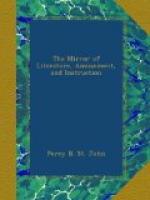Quoting from the same poem, we may truly say of Sawston Hall, Cambridgeshire—“The mansion’s self is vast and venerable,”—for it is one of the most pleasing architectural relics of the “elder time,” which at present exists in England. The house, a large, old, substantial mansion, built partly, as says the tradition, from the walls of Cambridge Castle, has been the property of the Roman Catholic family of Huddleston, for some centuries; and assuming its present appearance early in the reign of Queen Mary, has, with only the trifling alterations incidental to necessary repairs, retained it; for the Huddlestons, inhabiting Sawston Hall, and residing there in each generation, highly respected as country gentlemen, either from the extravagance of some of the family, or from a taste for old associations, have been prevented from altering it. As the manor house, it stands near the church; the baronial chiefs who were always lords of the manor, frequently building, if seldom patronizing, their village churches.
The mansion is a large, square building, situated in a garden, wherein may be observed the remains of aggera, a moat, terrace, &c.; a river so shallow that it might be easily forded, flows at the back of the house, and serves as one boundary to this garden. In the very small inner court, stands a tower, enclosing a spiral staircase, which leads to the top of the house; the whole length of the southern front of it is occupied by a gallery, and the dormitories upon this floor, which communicate with each other, are hung with old tapestry. The principal entrance is through a porch and door, which opens immediately into the baronial hall, a curious place certainly, but slightly differing in arrangement and appearance from what we had previously seen at Arundel Castle, Haddon Hall, and several colleges. The oriel window, instead of its usual place at the upper end of the hall, was situated on one side, very near the corner; in the recess formed by it, stood the baron’s table, not as we had anticipated upon a dais, but at least so veiled from the vulgar gaze of the retainers who feasted at a separate board in the apartment, that it answered the purpose of distinguishing ranks equally well. The hall is paved with red brick, and has a large, open fire-place, intimating well the hospitable spirit of former days; its panels, curiously carved, are painted white and brown; the latter in imitation of walnut wood, is probably a mere coating of paint drawn over the original panels of that material, to ensure their preservation. Here too are the arms of the family emblazoned, in which may be observed the lion of Britain and Fleur-de-lis of France, the Huddlestons being descended from, or united to, the royal line of each nation.




